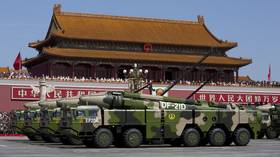China develops hypersonic ‘smart shell’ – media

Chinese naval scientists claim to have created a so-called ‘smart shell’ that is capable of delivering a precision strike to a target at hypersonic speeds, the South China Morning Post (SCMP) reported.
The shell, which Beijing says can travel at Mach-7 speed, or seven times the speed of sound, is capable of changing its flight plan with the use of satellite navigation systems, the outlet said on Monday.
The state-of-the-art weapons delivery system can also deliver a warhead to a target with a margin of error of less than 15 meters, it added. Its precision-strike capabilities may make it insufficient to attack smaller mobile objects like tanks, but it would theoretically be ideal for larger, static targets such as warships, or ports.
The development of the military technology, the SCMP said, builds on the US Navy’s proposed development of the ‘dream shell’ – a similar weapons system that was theoretically intended to navigate at a speed of Mach 5 and be guided by GPS satellite signals.
The US military first proposed the concept in 2012, indicating its intention to test-fire the ‘dream shell’ within five years, the SCMP said, but that deadline passed in 2017. By 2021, the US military had abandoned research and development of the weapons system, the report adds.
The Chinese team who developed the Mach-7 shell also said that, while the US began its development of the technology first, they themselves had received no support from Western scientists.
“We had no guidance, not even a cursory introduction to guided missile navigation systems, especially the satellite navigation component,” Feng Junhing of China’s Naval University of Engineering wrote in an engineering journal in November.
The shell technology is expected to be widely used in battlefield scenarios, given that it is relatively cost-effective to produce but maintains the long-range, precision-striking capabilities more often associated with missiles.
During launch, though, the shells generate a significant electromagnetic field which can subsequently damage electronic components such as microchips or antennae, potentially destroying its own satellite navigation system.
The Chinese scientists say they bypassed this problem by developing an antenna that can withstand electromagnetic signals, while also maintaining precise satellite navigation.
Beijing’s navy has recently said that it has made a series of breakthroughs in weapons development, particularly in the field of electromagnetic weapons, the SCMP said, adding that ‘war game’ simulations of new military hardware challenges the traditional advantages held by Western nations.













